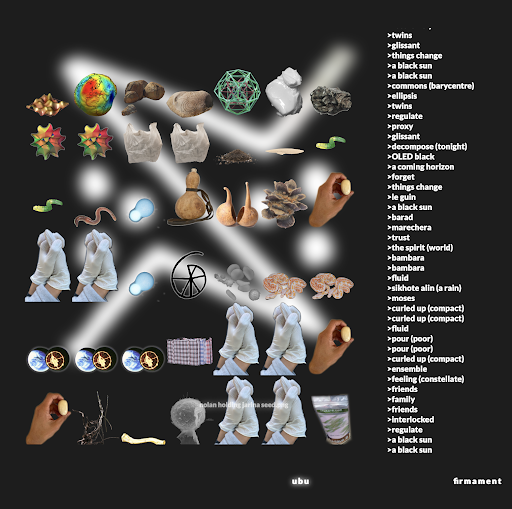Still image from the video artwork Sesasedi sa Tsodio (2021-2023) by Rangoato Hlasane. Photograph by Bongani Mndaweni. Image courtesy of the artist.
Still image from the video artwork How Many ____ Does It take? (2020) by Simnikiwe Buhlungu and Tessa Mars. Image courtesy of the artists.
Still image from the video artwork We are the ambassadors of the blurred mirages of lands that never fully materialize (2020) by The School of Mutants. Image courtesy of The School of Mutants.
Still image of the digital game a sun.black (2021) by Nolan Oswald Dennis (developed with Noa Mori). Image courtesy of the artist.
Sohlangana emlanjeni nna?
Simnikiwe Buhlungu & Tessa Mars, Nolan Oswald Dennis (developed with Noa Mori), Rangaoto Hlasane and The School of Mutants.
Curated by Amogelang Maledu.
Long Gallery - 09.05.2024 - 07.06.2024
Sohlangana emlanjeni nna? loosely: will we ever meet at the riverbanks though? is an exhibition programme that showcases time-based media artworks by four African and African diaspora artists. The title of the exhibition is inspired by a Mafikizolo (South African Afro-pop music group formed in 1996) love song Emlanjeni, released in 2004. However, the title here is reinterpreted as question-cum-injunction. The exhibition takes the song as a point of departure to ambivalently think through the art, culture and political ideologies of pan-Africanism broadly, as an ethic and poetical practice of romance: ultimately pan-Africanism as love.
I use the term pan-Africanism informed by Tsitsi Ella Jaji via George Shepperson perspective distinguishing the small “p” and capital “P” in p/Pan-Africanisms. Small “p” pan-Africanism designates an eclectic set of ephemeral cultural movements and currents throughout the twentieth century ranging from popular to elite forms in contradistinction to the more formal organisations comprising capital “P” Pan-Africanism such as the series of global gatherings from London conference of 1900 organised by H. Sylvester Williams, to the five congresses between 1918 and 1945 in Europe (in which W.E.B. Du Bois played prominent roles), as well as subsequent gatherings on the African continent in Tanzania, Ghana, and beyond. Similar to Jaji, I concede that “the distinction between these two forms was never absolute ... [because] the informal and formal registers of transnational black solidarity have variously reinforced, cross-fertilized, and interfered with each other”.
Through time-based media artistic practices of artists Simnikiwe Buhlungu and Tessa Mars, Nolan Oswald Dennis (developed with Noa Mori), Rangoato Hlasane and The School of Mutants, the exhibition dialogues (un)intentional generative connecting points – solidarities – of the heritage, present and future of the continent as well as its people-presence everywhere in the world. Posed as a question, the exhibition is meant to be inquisitive, curious and heretical: lovingly questioning history and the future of the continent as ongoing currents and present realities – history as now. As an injunction, the exhibition demands a nestling within the contradictions of pan-Africanism in practice. The exhibition considers the overwhelming disappointment in many (African) countries’ contemporary political contexts where (social) justice is concerned. From electoral politics, developing democracies, so-called failed states to ongoing ontological violence that also fissures the environment too.
Accompanying the exhibition programme is a reading and music room including books from my personal collection and curated playlists to facilitate a forum of deep reading and listening. In this way, this room interlaced with intertextual popular cultures, cultivates interdisciplinary ways of the artistic and cultural production in thinking about pan-Africanism and its divergent confluences. It also sparks curiosity, discussion and debates entrance points on the movement’s art, cultural and knowledge production. Tangentially, the accompanying room also reads and sounds out collective listening in-and-out of the possibilities and limits of solidarity that pan-Africanism espouses.
Sohlangana emlanjeni nna? showcases time-based artworks with sonic, visual and playful registers that nuance the continuous ambiguities and possibilities of (in)justice in a continental landscape that was historically transformed into extracted resources as endlessly renewable as its bonded workforce. Thus making a diasporic engagement of pan-Africanism a necessary interchange in considering the displacements that came with modernity that is not only inherent in Africa, but in the continent’s historical imperial entanglements. The poetics of relations as per Édouard Glissant’s teachings.
Thus, the exhibition engages the practice of self-determination by reflecting on heretical, fugitive, unstable and seriously playful philosophical orientations of pan-African solidarity. The exhibition indulges some of the questions central to the pluraliversal realities, cosmologies, political ideologies and cultural artistic knowledge production that informs the time-based media artworks of these four African and African-diasporic artists’ visual vocabularies. Ultimately, Sohlangana emlanjeni nna? – as an injuncting and questioning exhibition on pan-Africanism as love – also wrestles with the frustration of hopefully waiting for this love. How long are we to bear pan-Africanism’s perennial project of ethical poetics and politics? Sohlangana emlanjeni nna? Are we indeed ever going to meet at the riverbanks though?
The format of this exhibition asks for the audience’s time too: repeat visits; focused attention on one time-based artwork per visit; lounging on bean bags reading and listening to music. A necessary ‘tedium’ and intentional commitment that the ongoing project of (Black) liberation similarly demands of us: deliberate sustained attention.
Curatorial statement by Amogelang Maledu.
This project was made possible thanks to the support by the Department of Sports, Arts and Culture. Celebrating 30 Years of Democracy.





